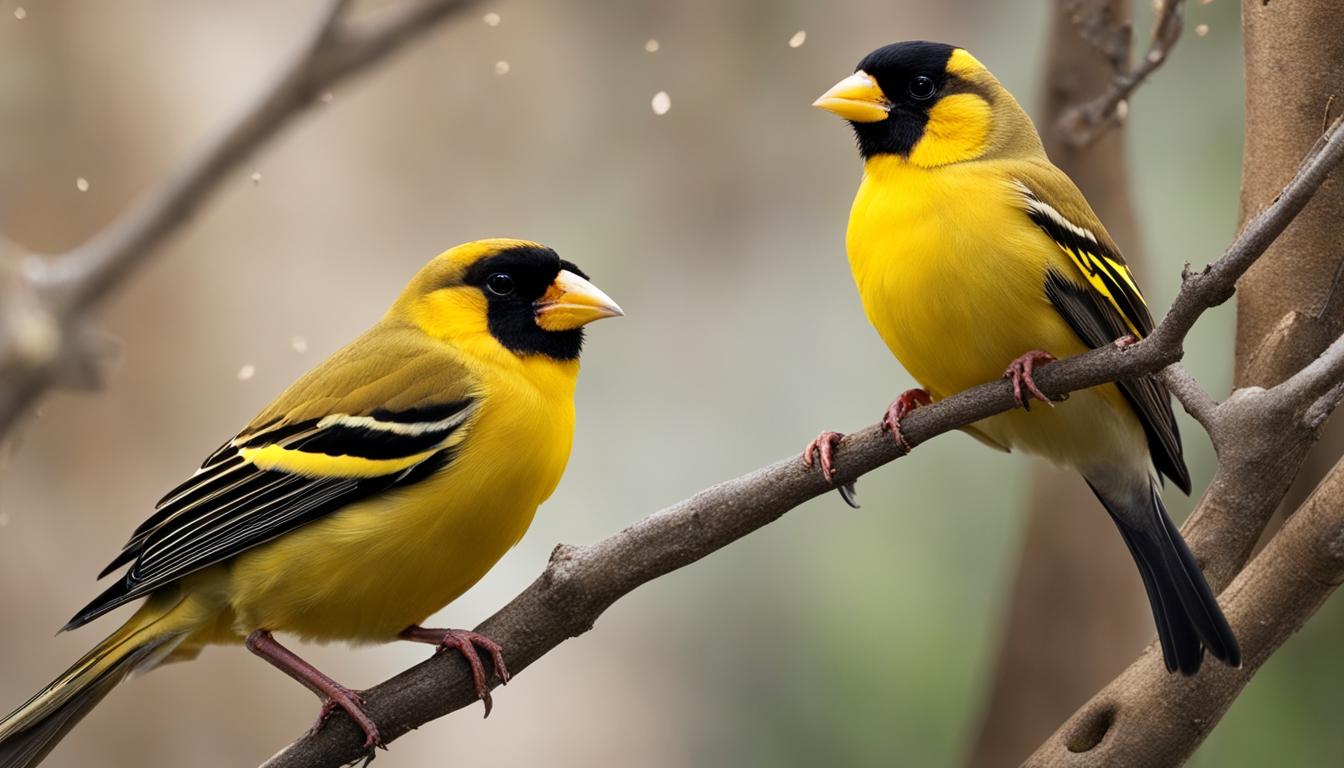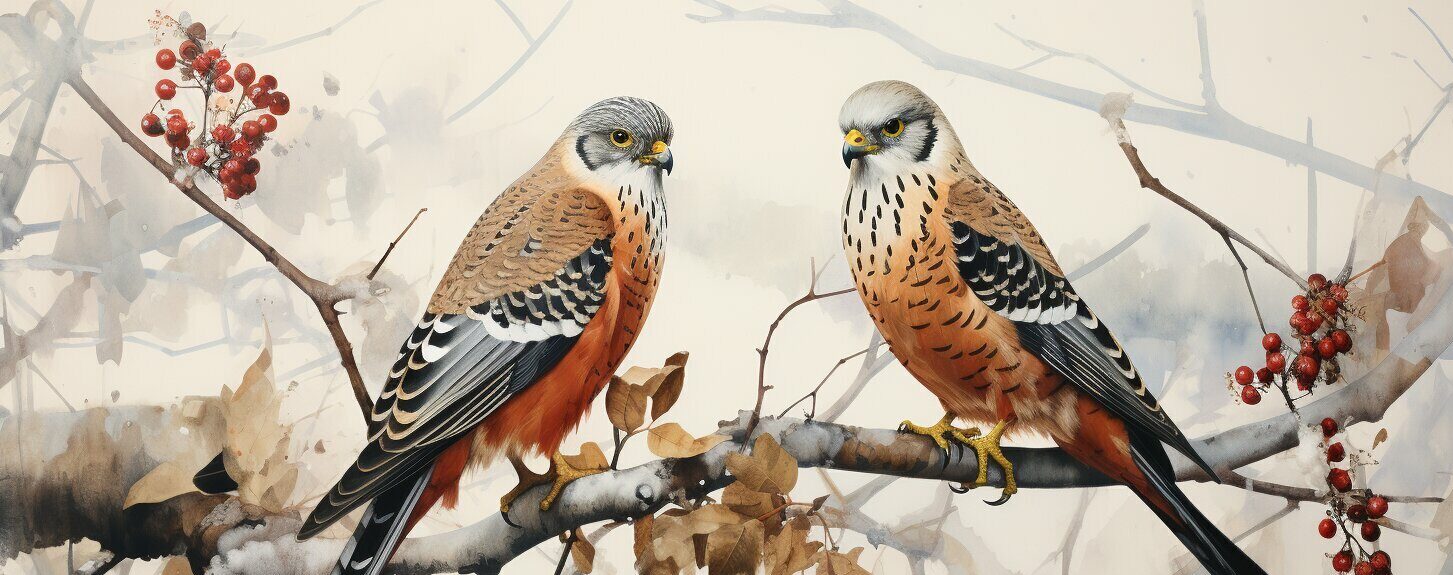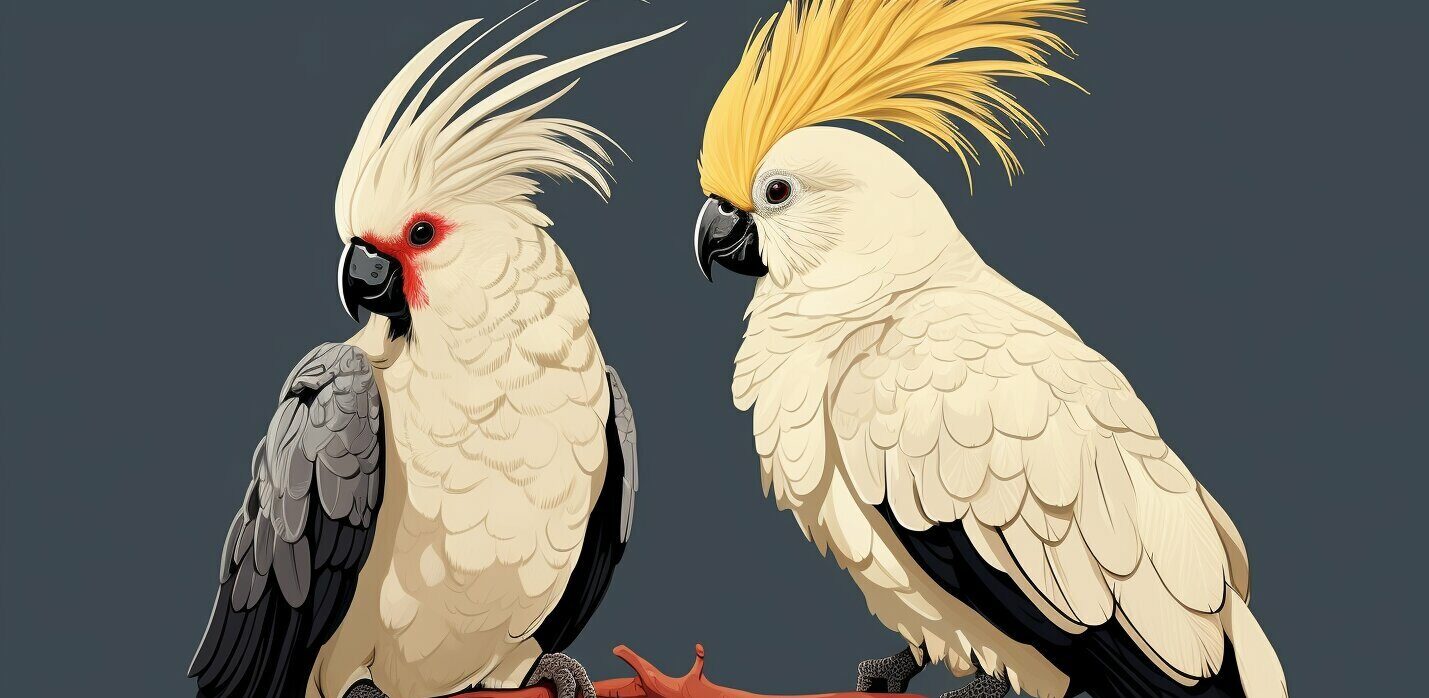As bird enthusiasts, we often marvel at the incredible diversity displayed by different species, and that includes the fascinating differences between canaries and finches. While both canaries and finches are small, charming birds that can captivate hearts, they have very distinctive attributes in terms of color and song. In this article, we will delve into the world of canaries vs finches, exploring their unique characteristics and understanding the significant differences between these two popular avian species.
Key Takeaways
- Canaries and finches are small birds with varying colors and distinctive songs.
- While canaries are known for their bright yellows, they actually come in a wide range of other colors as well.
- Finches showcase an array of bold hues and intricate patterns exclusive to their species.
- Canaries are famous for their melodic songs, while finches have unique vocalizations that play a significant role in their social interactions and mating rituals.
- Both the color and song in canaries and finches are influenced by factors such as genetics, environment, and behavioral traits.
Introduction to Canaries and Finches
Canaries and finches are two captivating bird species adored by bird enthusiasts for their distinct characteristics, including their vibrant colors and melodious songs. In this section, we will delve into the fascinating world of these birds by exploring their origins, general traits, and the appeal they hold for avian lovers.
Canaries, scientifically known as Serinus canaria, are native to the Canary Islands, Madeira, and the Azores. These small yet colorful songbirds are widely recognized and treasured for their melodic tunes. Bred in various shades and patterns, canaries serve both as delightful pets and impressive show birds. Their size ranges from 4.5 to 8 inches, depending on the breed, and they generally have a life expectancy of up to 10 years in captivity.
Finches, on the other hand, belong to the family Fringillidae and are found across all continents except Australia and Antarctica. With over 140 species, finches display an array of vibrant colors and striking patterns. They are lively, social birds known for their intricate vocalizations. Finch body length typically varies between 3.5 to 6 inches, and they have a life expectancy similar to canaries, ranging anywhere from 5 to 10 years in captivity.
When it comes to popularity among bird enthusiasts, both canaries and finches share the limelight, albeit for different reasons. For many bird-keepers, the allure of canaries lies in the myriad of colors combined with their enchanting songs. Finches, on the other hand, captivate people with their vivacious nature, striking patterns, and unique vocalizations, providing endless entertainment for those who appreciate avian beauty.
Let’s take a closer look at some key differences between canaries and finches concerning their coloration and songs:
| Canaries | Finches | |
|---|---|---|
| Color Varieties | Yellow, orange, red, white, and more | Green, red, blue, yellow, and numerous striking patterns |
| Vocalizations | Renowned for their melodious and tuneful songs | Unique chirping sounds that differ between species |
| Size | 4.5 to 8 inches, depending on the breed | 3.5 to 6 inches, depending on the species |
| Life Expectancy in Captivity | Up to 10 years | 5 to 10 years |
With a solid introduction to the captivating worlds of canaries and finches, the following sections will delve deeper into their color variations and song distinctions, allowing for a more comprehensive understanding and appreciation of these small yet beautiful birds.
Physical Characteristics: Understanding Color Variations
Both canaries and finches are celebrated for their beautiful colors, but their displays of plumage are distinct from each other. In this section, we will explore the striking color differences of these avian species, focusing on their palettes and the factors that influence their hues, patterns, and variations.
The Palette of Canaries: Bright Yellows and Beyond
Canaries are well-known for their signature bright-yellow feathers, but these captivating birds exhibit a diverse range of colors influenced by genetics and breeding practices. Breeders have developed canary breeds that showcase stunning shades of yellow, red, orange, white, and even green.
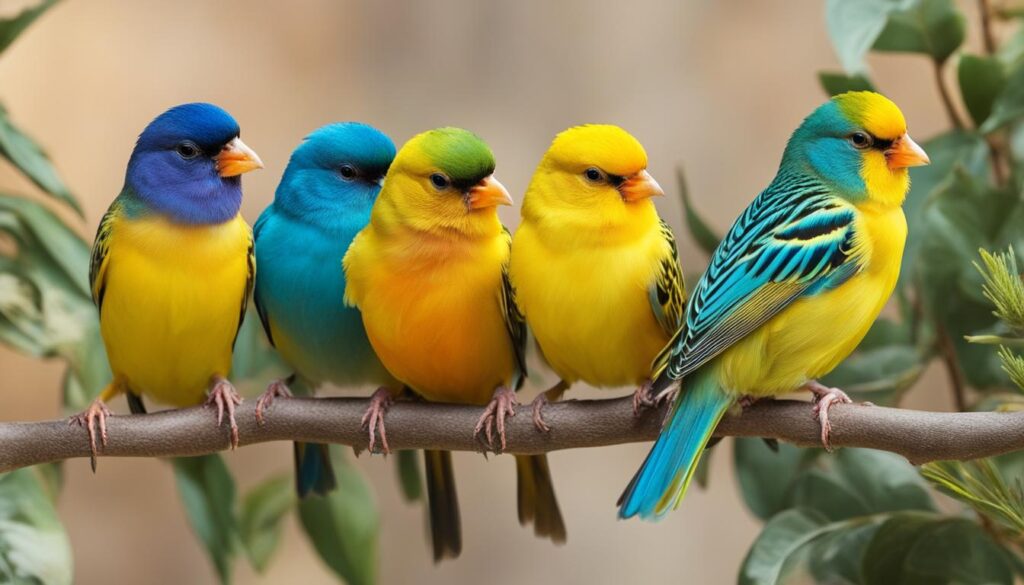
Some noteworthy examples of canary color variations include:
- The red factor canary, which displays a striking salmon to deep red coloration
- The white canary, characterized by its pure-white plumage
- The cinnamon canary, showcasing an attractive cinnamon-brown shade
- Green canaries, exhibiting a subtle greenish hue mostly seen in wild canaries
These variations demonstrate the potential for immense color diversity within the canary species.
Finches’ Feathered Rainbow: Bold Hues and Patterns
Finches, too, exhibit a dazzling array of colors and patterns, fascinatings bird enthusiasts with their diverse appearance. From vibrant reds and blues to more subdued earthy tones, these birds truly boast a feathered rainbow.
A few examples of finches showcasing striking color variation include:
- The Gouldian finch, displaying a vivid combination of blue, green, yellow, and red
- The zebra finch, characterized by its black-and-white striped tail and red beak
- The purple finch, showcasing a raspberry-red head and breast
- The greenfinch, exhibiting a striking olive-green plumage
These color patterns and combinations captivate with their bold hues, intricate designs, and variation within the finch family.
Genetics and Environment: Influences on Coloration
Both genetic and environmental factors play significant roles in determining coloration and patterning in canaries and finches. Selective breeding practices have led to birds with specific colorations, patterns, and traits, while environmental factors can influence the vibrancy of their feathers.
Genetic mutations often contribute to the color diversity in canaries and finches, introducing new hues and unique feather patterns. Breeding birds with specific desired traits or similar colors reinforce these mutations, leading to diverse breeds and varieties.
Meanwhile, environmental factors such as nutrition, sunlight exposure, and stress levels can also have a direct impact on plumage. For example, finches and canaries with a diet rich in carotenoids—pigments found in fruits, vegetables, and insects—will display more vibrant and intense colors, whereas nutritional deficiencies can result in duller, less vivid feathering.
Understanding the complexities of canaries vs finches color differences requires a comprehensive perspective on the genetic factors, breeding practices, and environmental variables affecting their beautiful plumage.
Canaries vs Finches: A Comparison of Song
While both canaries and finches are admired for their vocal abilities, their songs exhibit unique traits and serve distinct purposes that set them apart. Below, we explore the characteristics of their songs, highlighting the melodic tunes of canaries and the distinctive chirping of finches.
The Melodic Tunes of Canaries
Canaries are well-known and beloved for their remarkable melodic tunes. With extraordinary range, pitch, and complexity, the canaries’ songs are unmistakable and captivating to bird enthusiasts everywhere. Considered the virtuosos of the avian world, these birds have been bred selectively to improve their song quality.
The variety and depth of the canaries song are influenced by numerous factors, such as genetics and environmental conditions. Certain breeds, like the Waterslager Canaries, have garnered renowned reputations for their melodious and harmonious singing abilities. Below is a comparison between two popular canary breeds and their distinct song characteristics:
| Canary Breed | Main Song Features | Significance in Breeding |
|---|---|---|
| Waterslager Canaries | Deep and melodious, resembling the sound of water | Prized for the unique water-like sounds and variations in pitch |
| Roller Canaries | Soft and continuous, akin to a gentle whistle | Valued for their soothing and continuous notes with minimal gaps |
Finches’ Chirping Choir: Distinctive Vocalizations
Although finch songs might not be as melodic as those of canaries, their distinctive vocalizations still play a significant role in their social interactions and mating rituals. Each finch species reflects a unique sound, as they engage in various auditory communication techniques to share information and stay connected within their community.
These bird species also display a diverse chirping choir of songs and calls, depending on their situations. For instance, the singing patterns of Zebra Finches and Gouldian Finches differ as follows:
- Zebra Finches:
- Repeated series of short, high-pitched calls and songs for courtship.
- Vocalizations serve as an essential part of their mating display.
- Slightly softer, melodious songs with distinct trills and whistles.
- Their songs are crucial for mate recognition and maintaining pair bonds.
In conclusion, the unique features and purposes of canaries and finches song differences make these birds fascinating and popular among bird enthusiasts. Whether one appreciates the enchanting melodies of canaries, or the functional vocalizations of finches, one can’t deny the allure of these charming avian species.
Behavioral Traits Influencing Color and Song
Canaries and finches exhibit certain behavioral traits that have a significant impact on their coloration and song. These behaviors include mating displays, territoriality, and social hierarchy. Both species have evolved unique strategies to showcase their vibrant hues and vocalizations in order to attract mates, establish territories, and assert their position in the social order. This section delves into how these behaviors influence the color and song of each species.
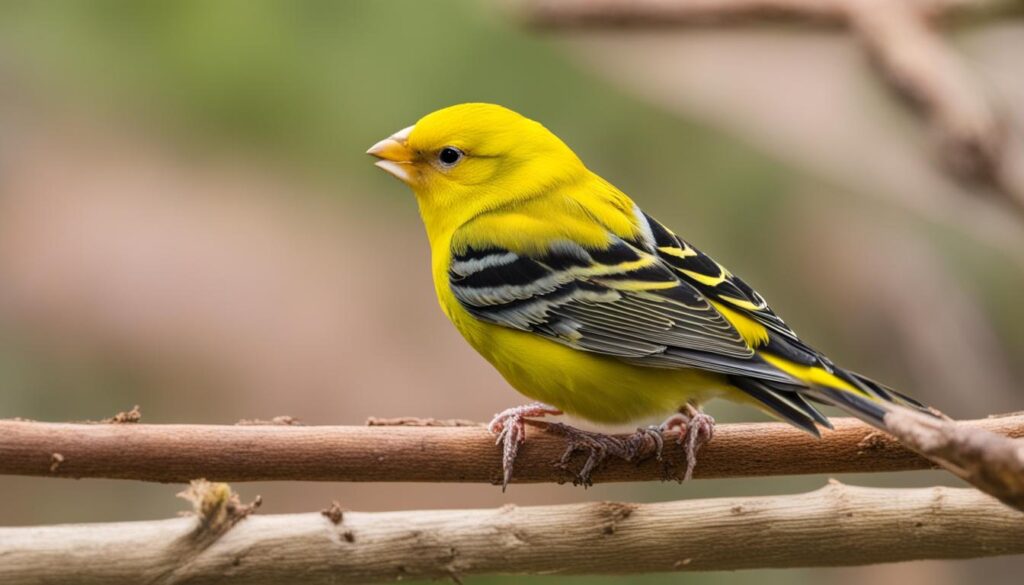
Mating Displays and Their Impact on Color and Song
In canaries, the male’s song serves as an essential part of its mating display. Males with more complex and melodious songs are more attractive to females. Additionally, brightly colored canaries stand out more and are seen as potential mates, leading to a preference for the species’ iconic yellow hue. In contrast, finches rely on their bold colors, unique patterns, and distinctive vocalizations to attract the attention of potential mates. Males of certain finch species may perform elaborate mating dances, sing distinct songs, or even build intricate structures in their pursuit of a mate.
Territoriality and How It Influences Color and Song
Both canaries and finches use their coloration and vocalizations to establish and defend their territories from rivals. In canaries, males with more powerful songs tend to have greater success in defending their territories. Their bright coloration also plays a role in asserting dominance, with more vibrantly colored males often being seen as more formidable. Among finches, territorial behavior is displayed through loud and unique calls that signal the presence of an individual, its fitness, and its claim to a specific area. Finches may also use their eye-catching colors and patterns to intimidate potential rivals and prevent encroachment on their territory.
Social Hierarchy and Its Effects on Color and Song
Canaries are more solitary birds, with their social hierarchy mainly revolving around dominance in mating and territory. Consequently, their bright colors and melodious songs are crucial factors in determining their position in the pecking order. On the other hand, finches have complex social structures, and their hierarchy is often established through displays of color, pattern, and vocalizations. Dominant individuals are typically more colorful and have unique vocalizations that reflect their status within the group.
| Species | Mating Displays | Territoriality | Social Hierarchy |
|---|---|---|---|
| Canaries | Complex, melodious songs and bright coloration | Powerful songs and vibrancy of color | Established primarily through mating and territory dominance |
| Finches | Bold colors, unique patterns, and distinctive vocalizations | Loud calls and eye-catching colors | Complex social structures with hierarchy determined by displays of color, pattern, and vocalizations |
In summary, the behavioral traits in canaries and finches play a vital role in influencing their coloration and vocalizations. From mating displays to territorial behavior and social hierarchy, the ability to attract mates, defend territories, and assert dominance within their respective species hinges on their colors and songs. Understanding these behaviors and their connection to the physical attributes of these captivating birds adds a new layer of appreciation for their incredible diversity and adaptations.
Nesting Habits and Their Impact on Appearance and Vocalization
Understanding the nesting habits of canaries and finches can shed light on the differences between these two bird species, particularly in terms of appearance and vocalization. Their unique nesting behaviors, habitats, and social interactions reflect and impact their vibrant coloration and distinct singing abilities.
Canaries: Solitary Songsters with Simple Nests
Canaries are known for their solitary nature and beautiful songs. Their nesting habits are a reflection of this individualism. Canaries prefer to make simple nests that are usually composed of subtle materials like grass, twigs, and plant fibers, forming a small, unassuming cup-shaped structure. This modest approach to nesting allows the canaries to focus on their primary purpose: singing. By building simple nests, canaries can devote more time and energy to developing and perfecting their melodious tunes, resulting in an unmatched vocal mastery among birds.
Their vibrant coloration further complements their solitary nature. Since they focus on attracting mates using their songs instead of nesting displays, the bright hues of canaries serve as a secondary method for attracting mates and winning territory.
Finches: Community Dwellers with Elaborate Constructions
Finches, on the other hand, are social birds that thrive in communities. Their nesting habits highlight this communal lifestyle. Unlike canaries, finches build elaborate nests that showcase their craftsmanship and creativity. Finches use a variety of materials, such as plant fibers, leaves, moss, and even animal hair, to create their intricately woven nests. These complex structures are integral to their social bonding and mating rituals.
Table: Canary and Finch Nesting Habits Comparison
| Feature | Canaries | Finches |
|---|---|---|
| Nesting Behavior | Solitary | Communal |
| Nest Construction | Simple, cup-shaped | Elaborate, intricately woven |
| Material Choice | Grass, twigs, plant fibers | Plant fibers, leaves, moss, animal hair |
| Nesting Impact on Vocalization | Focuses on song development and perfection | Vocalization plays a role in social interaction and nesting cooperation |
As a result of the finches’ focus on elaborate nests and complex social structures, their vocalizations differ from the melodic tunes of canaries. Although not as intricate in song structure, finches use their unique chirps and calls to communicate with one another and attract mates. The relationship between their nesting habits and vocalizations is evident in their diverse songs that convey the character of their social interactions, territory establishment, and nesting displays.
Ecosystems and Habitats: Where Canaries and Finches Thrive
Understanding the habitat preferences of these captivating birds reveal essential factors that contribute to the health and survival of both canaries and finches. In this section, we will discuss the unique ecosystems in which these species flourish and how habitat influences their coloration and songs.
Canaries: Island Dwellers in the Atlantic Ocean
While canaries have been domesticated and bred in captivity for centuries, their wild cousins primarily inhabit the Canary Islands, Azores, and Madeira Island. The pristine environments found on these islands provide abundant food resources, including a variety of seeds, insects, and fruits. Additionally, the islands’ mild climate and diverse vegetation create an ideal setting for canaries to thrive.
Their habitat preferences also play a role in the vibrant yellow coloration of wild canaries. The availability of certain dietary components, specifically carotenoids obtained from consuming seeds and fruits, enhances the intensity of their yellow feathers. Similarly, their melodic songs have been influenced by the dense vegetation of their habitats, echoing through forests and serving as an important component in their mating rituals.
Finches: Adaptable Inhabitants Across Diverse Regions
Finches are known for their adaptability and can be found throughout various ecosystems around the world, ranging from forests and grasslands to deserts and high mountains. The habitat preferences of finches often vary by species, with some species being more specialized to specific environments.
- Desert Finch: Found in the arid habitats of Northern Africa and the Middle East, the Desert Finch is well-suited to survive in these extreme environments.
- House Finch: Originally native to North America’s southwestern regions, the House Finch has now expanded its range across most parts of the continent.
- Zebra Finch: An iconic species native to Australia, this popular pet bird thrives in the diverse habitats ranging from arid plains to eucalyptus forests.
The diversity of habitats and food sources for finches has influenced their distinct color patterns and vocalizations. For some species, bold hues and patterns help them to blend into their surroundings, while for others, they serve as important signals for mate selection. Similarly, the song repertoire of finches has been shaped by their specific habitat preferences, with some species developing songs based on the sounds of their surroundings, aiding in communication and reproduction.
In conclusion, the various canaries and finches ecosystems play a critical role in shaping the unique characteristics of these species. By examining their habitat preferences, we can gain essential insights into the behaviors, coloration, and songs displayed by these remarkable birds.
Conclusion
In this article, we have explored the fascinating world of canaries and finches, delving into their distinct colorations and songs. We have seen how these captivating birds showcase a variety of hues and melodies, making them a popular choice among bird enthusiasts. As we have observed, summarizing canaries vs finches comparison has allowed us to shed light on the unique beauty and behaviors intrinsic to each species.
From their vibrant shades to their melodious tunes, color and song in canaries and finches are vital aspects that differentiate them. A deeper understanding of the factors that influence these attributes, such as genetics, environment, and behaviors, has offered us greater insight into their fascinating lives. Through this exploration, a newfound appreciation for these birds can be formed, inspiring us to cherish and protect the diverse avian beauty found in nature.
Lastly, we hope that this in-depth look into the alluring world of canaries and finches has left you with a sense of wonderment. From their diverse color palettes to their varied songs, these remarkable birds display unique qualities that make them stand out in the avian world. We encourage you to explore further and relish the delightful experiences that these beautiful creatures have to offer.
FAQ
What are the main color differences between canaries and finches?
Canaries are known for their bright yellow color, but they can also come in a variety of other hues such as orange, red, and white. Finches, on the other hand, have a wider array of colors and patterns, ranging from the striking red of a male house finch to the subdued hues of the zebra finch.
How do the songs of canaries and finches differ?
Canaries are renowned for their melodic tunes, which can be complex and varied in pitch and tone. Finches have distinctive vocalizations that may not be as melodious as canaries’, but they play a crucial role in their social interactions and mating rituals.
What factors influence the coloration of canaries and finches?
Both genetic and environmental factors contribute to the color differences between canaries and finches. Genetics determine the base color of a bird, while environmental factors, such as diet, can affect the vibrancy of their feathers.
How do the behavioral traits of canaries and finches impact their color and song?
The behavioral traits unique to canaries and finches, such as mating displays and territoriality, can have an influence on their coloration and vocalizations. For example, the vibrant colors of canaries may play a role in attracting mates, while the various vocalizations of finches can signal different messages related to territory or mating status.
How do the nesting habits of canaries and finches differ?
Canaries typically prefer a solitary lifestyle with simple nesting habits, focusing on their individual song. In contrast, finches tend to have more elaborate nesting structures and often live in bustling communities, reflecting the intricacies of their social hierarchies and interactions.
What are the natural habitats of canaries and finches, and how do they impact their color and song?
Canaries are native to the Canary Islands, Madeira, and the Azores, while finches are found in various habitats around the world, from forests to grasslands to urban environments. The ecosystems they inhabit directly affect their appearance and vocalizations due to factors such as food availability, temperature, and social dynamics.
 Skip to main content
Skip to main content